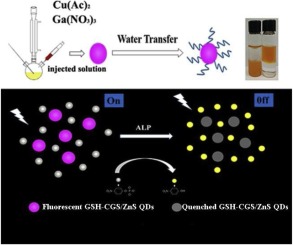当前位置:
X-MOL 学术
›
Colloids Surf. B Biointerfaces
›
论文详情
Our official English website, www.x-mol.net, welcomes your
feedback! (Note: you will need to create a separate account there.)
Synthesis of water soluble CuGaS2/ZnS quantum dots for ultrasensitive fluorescent detection of alkaline phosphatase based on inner filter effect.
Colloids and Surfaces B: Biointerfaces ( IF 5.4 ) Pub Date : 2020-03-19 , DOI: 10.1016/j.colsurfb.2020.110984 Xiaoxia Huangfu 1 , Yang Shen 1 , Anzi Yang 1 , Lixiao Liu 1 , Wen Luo 1 , Wenbo Zhao 1
Colloids and Surfaces B: Biointerfaces ( IF 5.4 ) Pub Date : 2020-03-19 , DOI: 10.1016/j.colsurfb.2020.110984 Xiaoxia Huangfu 1 , Yang Shen 1 , Anzi Yang 1 , Lixiao Liu 1 , Wen Luo 1 , Wenbo Zhao 1
Affiliation

|
Developing monitoring technique for alkaline phosphatase (ALP) is crucial due to the important role it plays in living cells. Here, a kind of biocompatible glutathione-modified CuGaS2/ZnS quantum dots (GSH-CGS/ZnS QDs) was used as a fluorescent substance and then fabricated "turn-off" fluorescent biosensor for detection of ALP by help of inner filter effect (IFE). Firstly, we prepared CuGaS2/ZnS (CGS/ZnS) QDs using solvothermal method and explored the efficient ligand (GSH) exchanges strategy for transferring oil-soluble CGS/ZnS QDs to aqueous phase. More importantly, we also explored the potential biological applications of the nanohybrid QDs. The obtained GSH-CGS/ZnS QDs emitted strong yellow fluorescence with the maximum excitation (400 nm) and emission (601 nm). Then, GSH-CGS/ZnS QDs were mixed with p-nitrophenylphosphate (PNPP) and ALP. PNPP could be hydrolyzed to p-nitrophenol (PNP) by help of catalysis of ALP, and the excitation spectrum of the GSH-CGS/ZnS QDs overlapped well with the absorption spectrum of PNP, so the fluorescence of GSH-CGS/ZnS QDs was initially quenched via the so-called "IFE". Finally, a novel "turn-off" biosensor for sensitive detection of ALP in the range of 0.05-10 U L -1(R2 = 0.98) with a detection limit of 0.01 U L-1 was successfully obtained. Results indicated that I-III-VI2 nanocrystals have great potential for their promising biomedical application.
中文翻译:

基于内部过滤效应的水溶性CuGaS2 / ZnS量子点的合成,用于碱性磷酸酶的超灵敏荧光检测。
由于碱性磷酸酶(ALP)在活细胞中起着重要作用,因此开发监测技术至关重要。在这里,一种可生物相容的谷胱甘肽修饰的CuGaS2 / ZnS量子点(GSH-CGS / ZnS QDs)被用作荧光物质,然后借助内部过滤效应(IFE)制成了“关断”荧光生物传感器来检测ALP。 )。首先,我们采用溶剂热法制备了CuGaS2 / ZnS(CGS / ZnS)量子点,并探索了将油溶性CGS / ZnS量子点转移至水相的有效配体(GSH)交换策略。更重要的是,我们还探索了纳米杂交量子点的潜在生物学应用。获得的GSH-CGS / ZnS QDs发出强黄色荧光,并具有最大激发(400 nm)和发射(601 nm)。然后,将GSH-CGS / ZnS QD与对硝基苯基磷酸酯(PNPP)和ALP混合。PNPP可以通过ALP催化水解为对硝基苯酚(PNP),GSH-CGS / ZnS QDs的激发光谱与PNP的吸收光谱有很好的重叠,因此GSH-CGS / ZnS QDs的荧光为首先通过所谓的“ IFE”淬火。最后,成功获得了一种新型的“关闭”生物传感器,用于灵敏检测ALP的范围为0.05-10 UL -1(R2 = 0.98),检出限为0.01 U L-1。结果表明,I-III-VI2纳米晶体具有广阔的应用前景。因此,GSH-CGS / ZnS QD的荧光首先通过所谓的“ IFE”猝灭。最后,成功获得了一种新型的“关闭”生物传感器,用于灵敏检测ALP的范围为0.05-10 UL -1(R2 = 0.98),检出限为0.01 U L-1。结果表明,I-III-VI2纳米晶体具有广阔的应用前景。因此,GSH-CGS / ZnS QD的荧光首先通过所谓的“ IFE”猝灭。最后,成功获得了一种新型的“关闭”生物传感器,用于灵敏检测ALP的范围为0.05-10 UL -1(R2 = 0.98),检出限为0.01 U L-1。结果表明,I-III-VI2纳米晶体具有广阔的应用前景。
更新日期:2020-03-20
中文翻译:

基于内部过滤效应的水溶性CuGaS2 / ZnS量子点的合成,用于碱性磷酸酶的超灵敏荧光检测。
由于碱性磷酸酶(ALP)在活细胞中起着重要作用,因此开发监测技术至关重要。在这里,一种可生物相容的谷胱甘肽修饰的CuGaS2 / ZnS量子点(GSH-CGS / ZnS QDs)被用作荧光物质,然后借助内部过滤效应(IFE)制成了“关断”荧光生物传感器来检测ALP。 )。首先,我们采用溶剂热法制备了CuGaS2 / ZnS(CGS / ZnS)量子点,并探索了将油溶性CGS / ZnS量子点转移至水相的有效配体(GSH)交换策略。更重要的是,我们还探索了纳米杂交量子点的潜在生物学应用。获得的GSH-CGS / ZnS QDs发出强黄色荧光,并具有最大激发(400 nm)和发射(601 nm)。然后,将GSH-CGS / ZnS QD与对硝基苯基磷酸酯(PNPP)和ALP混合。PNPP可以通过ALP催化水解为对硝基苯酚(PNP),GSH-CGS / ZnS QDs的激发光谱与PNP的吸收光谱有很好的重叠,因此GSH-CGS / ZnS QDs的荧光为首先通过所谓的“ IFE”淬火。最后,成功获得了一种新型的“关闭”生物传感器,用于灵敏检测ALP的范围为0.05-10 UL -1(R2 = 0.98),检出限为0.01 U L-1。结果表明,I-III-VI2纳米晶体具有广阔的应用前景。因此,GSH-CGS / ZnS QD的荧光首先通过所谓的“ IFE”猝灭。最后,成功获得了一种新型的“关闭”生物传感器,用于灵敏检测ALP的范围为0.05-10 UL -1(R2 = 0.98),检出限为0.01 U L-1。结果表明,I-III-VI2纳米晶体具有广阔的应用前景。因此,GSH-CGS / ZnS QD的荧光首先通过所谓的“ IFE”猝灭。最后,成功获得了一种新型的“关闭”生物传感器,用于灵敏检测ALP的范围为0.05-10 UL -1(R2 = 0.98),检出限为0.01 U L-1。结果表明,I-III-VI2纳米晶体具有广阔的应用前景。











































 京公网安备 11010802027423号
京公网安备 11010802027423号